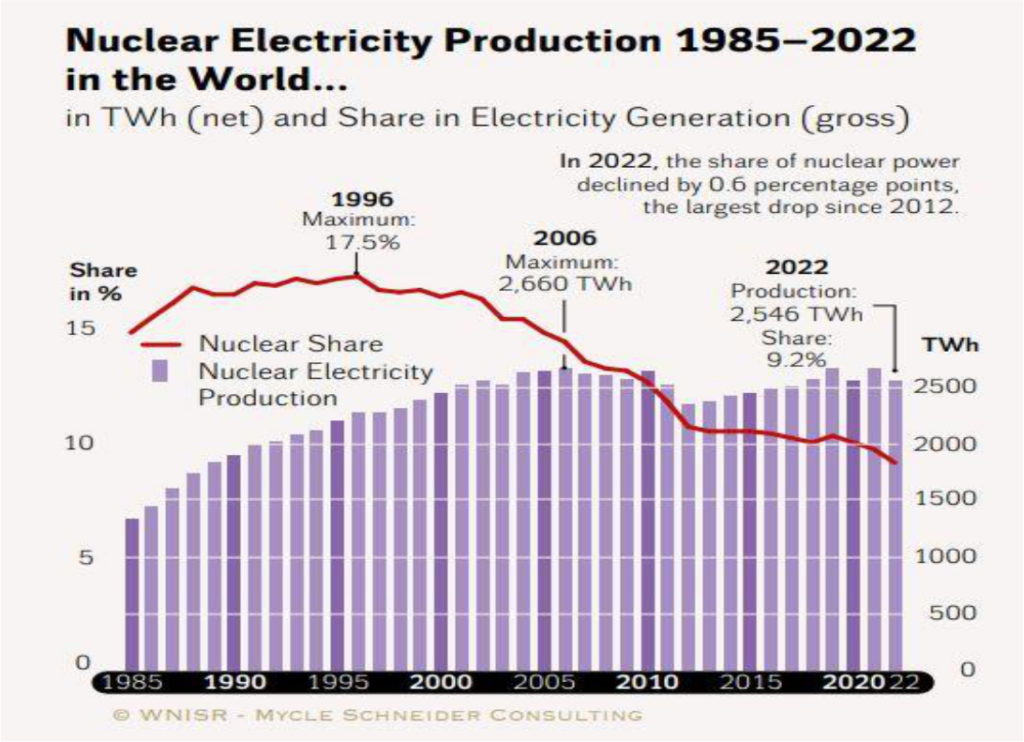Nuclear Monitor #911
Gerard Brinkman/Erik Plakman, WISE Netherlands
Every year, a group of international experts publishes the World Nuclear Industry Status Report. This report lists the most important nuclear developments worldwide. The most important conclusion in the 2023 edition: the decline in the share of nuclear power in global electricity production continues. There is no question of a nuclear renaissance. On the contrary, nuclear power is on its way out.
In 1996, nuclear power plants were producing at their maximum. At 17.5%, the share of nuclear power was at its highest worldwide in that year.

Meanwhile, the share of nuclear power has fallen to 9.2%. The big question, of course, is why. The most important thing is that the number of working nuclear power plants remains the same, while gradually more and more electricity is used in the world.

As of 2017, the number of nuclear power plants remains stuck at just over 400. It is true that new nuclear power plants are being connected, but about as many are being disconnected. This can be clearly seen in the balance sheet below.

From 2017 onwards, the blue line (new nuclear power plants) and the brown line (closures) are in balance.
Major National Developments in 2022
• Belgium. One reactor was closed in September 2022, and another one in January 2023. Three of the remaining five units are to close by 2025, while operation of the two most recent ones is to be extended until 2035.
• France. Nuclear generation dropped below the level of 1990. Compared to 2010, output plunged by 129 TWh, much more than the 100 TWh Germany lost in nuclear production due to its phaseout policy over the same period. For the first time since 1980, France turned into a net importer of electricity. Threatened by bankruptcy over record losses and unprecedented net debt levels (US$70 billion as of mid-2023), the utility company EDF was renationalized.
• Germany. The three last operating reactors were closed on 15 April 2023, twelve years after the definitive phaseout policy was decided in 2011.
• South Korea. State-owned utility KEPCO filed a record loss of US$202225 billion with net debt rising by 32 percent to an unparalleled US$2022149 billion.
• United Kingdom. Only nine units remain operating. The cost estimate for two reactors under construction at Hinkley Point C has reached US$202144 billion in February 2023, with first grid connection delayed to June 2027.
• United States. Nuclear share of commercial electricity generation declined to 18.2 percent, its lowest level in 25 years. After 10 years of construction, the first of two new reactors at Plant Vogtle was connected to the grid in April 2023. Cost estimates for the two units exceed US$35 billion.
China
There is still a major misconception about China. The persistent perception continues to circulate that nuclear power plants in China are constantly being connected to the grid. But what is happening there is that the share of renewable energy is increasing drastically.

The production of nuclear power is steadily increasing, but the growth of solar and wind is particularly spectacular. This trend is not only seen in China. Globally, the amount of investment in renewable sources is significantly higher than the amount of investment in new nuclear power plants.
Cost
Not only in absolute production, but also in economic terms, renewable energy sources continue to outperform nuclear power. Cost estimates for solar energy fell by 83 percent, wind by 63 percent, while the cost of nuclear power has increased by 47 percent in the last fourteen years. It should be mentioned that due to higher costs and inflation, solar and wind have also risen in price in recent years.

Small Modular Reactors
Although virtually no small nuclear power plants (SMRs) have been built, the topic continues to make headlines. There are dozens of designs, and media and governments write highly of the possibilities. In 2023, the Nuclear Energy Agency released an SMR dashboard , claiming that there has been “substantial progress toward SMR deployment and commercialization” and “much of this progress has occurred in the last two years.” In practice, two designs have come into production in the past two years: one in China and two floating reactors on ships in Russia. Incidentally, the latter two have load factors of 34 and 22% – which indicates that there are still major problems in development. This became very clear a few weeks ago when NuScale, a company in the US that has been working on the development of SMRs since 2007 (!), had to pull the plug on its flagship product. Financial problems were the deciding factor.
Renewable Energies Orders of Magnitude Ahead of Nuclear Power
• In 2022, total investment in non-hydro renewable electricity capacity reached a new record of US$495 billion (+35 percent), 14 times the reported global investment decisions for the construction of nuclear power plants. Wind and solar facilities alone generated 28 percent more electricity than nuclear plants and reached a 11.7 percent share of electricity generation, with nuclear shrinking to 9.2 percent.
• In China, solar PV produced a total of 423 TWh of electricity in 2022, for the first time overtaking nuclear power that generated 397 TWh. In the European Union, solar and wind plants together produced 624 TWh, for the first time exceeding not only nuclear energy (613 TWh) but also natural gas (557 TWh) and coal generation (447 TWh), while all renewable sources accounted for over 38 percent of the E.U.’s electricity production. In India, wind and solar plants together produced 3.7 times more power than nuclear reactors in 2022 Wind has outpaced nuclear in power generation since 2016. Solar passed nuclear generation in 2019. The report shows that the nuclear renaissance is not happening: the big change is in the increase in solar and wind, while the share of nuclear energy is decreasing. The entire report can be read on the site of the World Nuclear Report.